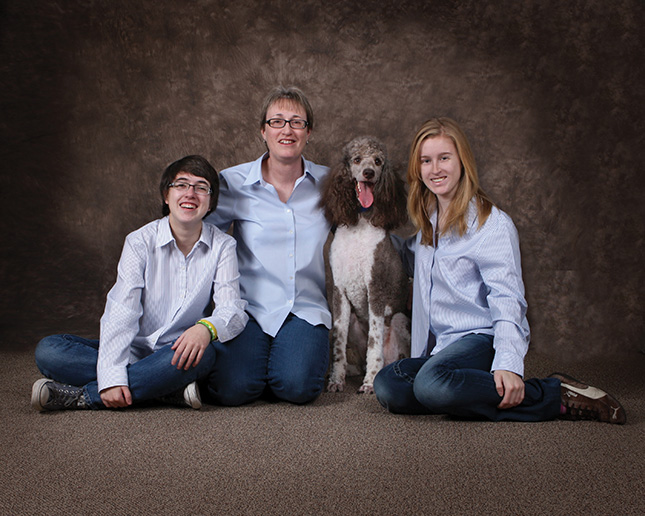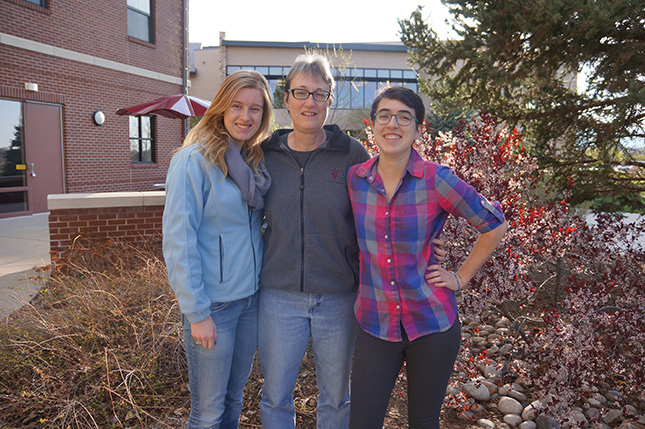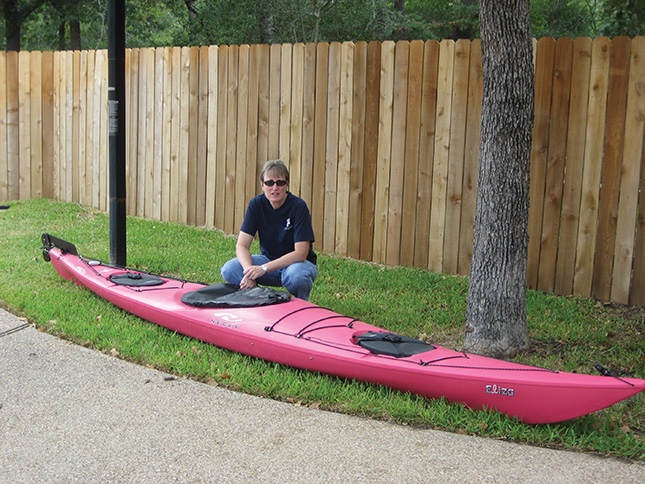Associate Dean Keeps an Eye on the Future
Kenita Rogers calls herself a “West Virginian through and through.” She was born in Huntington and grew up in Milton, West Virginia, spending many days volunteering in the local community with her mother. Her mother’s passion to give back and assist those less fortunate provided a solid foundation for Rogers’ future goals. She has passed that same passion on to her own two daughters, Hayley and Callie (see pages 58 and 60). Rogers earned her undergraduate degree from West Virginia University (WVU) in 1979. But before her college years, an event occurred that set her on a path to College Station: her mother married a game warden.

“I was 10 years old and my younger brother [Dr. Gary Brown] was eight when our biological father died,” Rogers said. “A few years later our mother was remarried to a gentleman who happened to be a game warden and was interested in farming. That’s when we started learning about cattle, horses, dogs, cats, and wildlife. We had a farm and raised polled Hereford cattle, lived on a game preserve in the summer and rode horses all day, and took in every stray and orphaned animal that showed up.”
Rogers and her brother were surrounded with animals of all shapes and sizes, so it seemed natural for her to go off to college after her high school graduation and study animal science at WVU. Two years later her brother joined her there-even though he thought he was headed in a different direction.
“He wanted to be a truck driver. He loved mechanical things, he still does. He rides motorcycles, has a helicopter and a plane, but growing up all he ever talked about was wanting to drive a big rig. He didn’t really want to go to college. “Our mother basically made him go,” said Rogers. “I filled out his registration forms and told him what classes to take, and so today, he’s a veterinarian too.”
Today, Brown owns two practices, one in southern West Virginia and one in Virginia. He has been vice president of the American Veterinary Medical Association and currently serves on the organization’s executive board. “I take great credit for his success as a veterinarian,” his sister said with obvious affection.
Her own post-graduate path led to Louisiana State University (LSU), and she admits that the climate was a big factor in her decision. “I may be the only person in the whole world who chose where to go to veterinary school based upon not enjoying cold weather. At that time, West Virginia had contracts with Ohio State University and LSU for its residents to attend veterinary school. I chose to go south. I was at LSU for four years and absolutely loved it. I loved the people, I loved the food, I loved the warm weather: I loved everything about it.
Rogers graduated first in her class and accepted a rotating internship at the University of Georgia, with plans to pursue a residency in small animal surgery. During this internship, she met a mentor that was pivotal in shaping her career plans, Dr. Jeanne Barsanti. “Dr. Barsanti was not only a wonderful small animal internist, she was an extraordinarily kind and patient teacher who was always true to herself. I wanted to be just like her and during that year, shifted my career emphasis to internal medicine.” Rogers’ husband had already accepted a position in Houston, so she was only able to apply for one internal medicine residency, at Texas A&M; University. “I was so lucky to get this residency opportunity. I arrived in the middle of August in 1983, and I just never left,” she said.
Another inspiring mentor
During Kenita Rogers’ residency, she acquired a passion for veterinary oncology while working alongside Dr. Claudia Barton, the only veterinary oncologist in the state of Texas at that time.
“She was an unbelievable mentor,” Rogers said, adding that, Barton got “every consult” in Texas. As this was the era before computers and e-mail, she communicated with colleagues via telephone. Rogers remembers her mentor’s white lab coat with “both pockets filled to the brim with pink notes” carrying the contact information that she would need to reach her veterinary colleagues that were requesting consultations. Rogers saw the opportunity to help Dr. Barton in her work. “She taught me, and I ended up staying on as an internist and oncologist, mainly because of her,” Rogers said. “We were the only two oncologists here for 27 years.”
Rogers passed her internal medicine boards and then took the oncology board examination in only the second year that it was offered. Since coming to Texas A&M; in 1983, she has completed a three-year internal medicine residency, was in a lecturer position for one year, then went through each rank in the tenure-track process as an internist and oncologist. She came to the dean’s office in 2006, where she has spent the last nine years as the associate dean for professional programs.
She “handed off” to two great oncologists who now serve in the hospital alongside Barton, Dr. Heather Wilson-Robles and Dr. Jesse Grayton. “I have said many times that I was really unhappy when Dr. Debbie Kochevar, currently dean at Tufts University, left Texas A&M;,” Rogers said. “In retrospect, I can now see that this event allowed me to move into the dean’s office and make way for the hire of Dr. Wilson-Robles, who has made a huge impact on Texas A&M; oncology. I give kudos to all three of the current oncologists; they are not only wonderful people but really talented doctors, quite adept at utilizing the diagnostic tools, imaging, and treatments that define an outstanding cancer center including chemotherapy, surgery, radiation therapy, and experimental treatments through clinical trials.” She noted the Diagnostic Imaging and Cancer Treatment Center at Texas A&M; is a state-of-the-art facility with diagnostic and treatment capabilities never before possible in one location. “The center is outstanding and I believe that Dr. Mike Deveau, who oversees the center, is one of the best radiation oncologists in the country.”
From faculty to administration
Kenita Rogers has been in the dean’s office for almost nine years, and her responsibilities have increased over that time, something of which she is proud. She oversees everything that pertains to veterinary students, from admissions to graduation. “We are in the midst of a substantial curriculum review, are continuously upgrading our selections process, and have our next accreditation visit in the fall,” she said. “Life is busy, exciting, overwhelming, and fun all at the same time.”
There were some impactful personal attitude shifts as she transitioned from faculty to administration. As a faculty member, she was certainly mindful of her students’ needs, but she also had to keep her own career progress moving forward. As an administrator, however, her focus has altered.
“I believe the best administrators switch totally away from that; it can’t be about my career anymore, it needs to be about everybody that I’m working with-it needs to be about their careers, not mine.”
She said she tries to make sure her main goal every day is to elevate everyone around her. “I have been so lucky to work with an incredible team in the Professional Programs Office. They are truly dedicated to serving the college, and are some of the most creative, kind, and hard-working folks that I know,” Rogers said.
Continuing in the classroom
“I am often asked if I miss working in the clinic,” Kenita Rogers said. “I really love what I do now, but I do miss some very specific things: the level and intensity of the teaching, working with really gifted colleagues in the hospital, both faculty and staff, and the truly wonderful clients that appreciate everything.”
Rogers still contributes directly to the education of Texas A&M; veterinary students; she taught the oncology elective until this year, and she continues to lecture on a variety of topics. She recalled a time last year when she and Barton put together a three-day cytology wet lab for the first time in a decade. “It was a lot of fun to revisit that,” she said, noting that it all came back, like riding a bicycle.
“As much as I am drawn to oncology, however, my main focus at this point is looking at the 10,000-foot view of our curriculum and making sure that it prepares our students to be some of the best veterinarians in the world,” she said. “We are so fortunate to be able to provide our students with hands-on opportunities that are unique to our program, including rotations at the Houston SPCA and Texas Department of Criminal Justice. Being open to new teaching opportunities is one of the best parts of my job.”
Presidential pups
Although Kenita Rogers serves in an administrative capacity now, she does occasionally see clinical patients-and some are VIPs. Rogers is still the veterinarian for President George and Barbara Bush’s dogs.
More serendipity was involved.
“In the old days, we did not have an emergency service. All of the internal medicine services were responsible for one Friday per month. [The Bushes] happened to have an emergency with one of their dogs on a Friday, and it happened to be my Friday. That’s how I met them.”
That dog was the Bush’s last springer spaniel. They now have two smaller dogs, which they bring in for their annual physical examinations, vaccinations and other healthcare needs. With the help of her colleagues in the Small Animal Hospital, Rogers still cares for them, and she wouldn’t want it any other way.
Tasks and perks
A major curricular review is currently underway, in parallel with the accreditation process that will culminate just after Thanksgiving. “The entire focus is ensuring that our curriculum is second to none in preparing students to be excellent veterinarians with strong Day One skills, regardless of their chosen career path,” Kenita Rogers said. “Our curriculum committee has developed a thoughtful and dynamic set of New Graduate Outcomes that are customized for Texas A&M; and are being mapped throughout the entire curriculum. We’re really looking at how we teach, what we are teaching, and how to take advantage of the exciting opportunities that the new teaching complex will bring to the college in 2016. I think that we are instituting some very cutting-edge improvements to the curriculum right now, and this is an extremely exciting time to be a faculty member in a program that is so dedicated to teaching and learning.”
As for honors associated with her current position, she feels really fortunate. She was thrilled when she was chosen as a Fish Camp namesake in the summer of 2014, in what became Doctor Rogers’ Neighborhood, #Rogerthat. “It was truly a fantastic, once in a lifetime experience!” she said. Led by upperclassmen for incoming freshmen, Fish Camp is a four-day orientation program with a goal of making their first year at Texas A&M; a success. She said she was honored to be included in the incredible Aggie tradition. She was also honored in 2013 with the Association of Former Student’s University-level Outstanding Achievement Award for Student Relations. Finally, she and her daughter Hayley received their Aggie rings on the same day. “I earned my MS degree in 1986, but was waiting for just the right moment to get my Aggie ring. It was really special to share that moment with her,” Rogers said.
She also served on the search committee to select the next Reveille and noted that it was quite a process. All of the dogs were wonderful, she said, but the decision makers were looking for a specific personality. “It had to be a dog with a special outlook, one that loved people and would be comfortable and happy in this environment. We saw some really cool, beautiful dogs, including the dog chosen to be Reveille IX,” she said.
Looking ahead

Kenita Rogers, devoted to fostering servant leadership in her students, looks forward to continuing on the board of directors for the Veterinary Leadership Institute (VLI), the group that runs VLE (Veterinary Leadership Experience), a camp for DVM students and faculty in Idaho each year that Rogers calls “truly impactful.” Through her work with the VLI and other organizations, she’s had the opportunity to “make change, be creative, and have a real impact on the profession,” something that she would like to continue.
Rogers said the CVM has an ongoing focus on developing student leaders, both by providing great role models, such as Dean Eleanor Green and other faculty and staff, and also by providing the climate and culture for being an authentic leader and “being the person that people want to look up to and follow.”
She’s also been appointed the director for climate and diversity for the college, a focus that has escalated in recent years. “The campus decided, in very meaningful ways, to show that diversity, climate, and equity were really important to Texas A&M.; Every college and unit has been tasked with emphasizing and improving in this area on a yearly basis. Each year, we provide a report, and every other year, we do a presentation on what has been accomplished at our college or unit.”
She said the university has backed the program financially and, because of that support, the opportunities for progress in diversity have been many.
Also unique to this campus is its broader definition of diversity.
“We think about race and gender, but it’s so much more,” Rogers said. “It’s about experience, it’s about socioeconomic status. It’s a lot of different attributes and parameters. It’s about visible and invisible disabilities. How do we handle all of that and make sure that everyone is successful?”
Also key is the emphasis on university climate. “Does everyone feel welcome here? Is this an environment where everybody looks forward to coming in to work every day, whether they are faculty, staff, or students?
“Do we tolerate things that shouldn’t be happening or do we address them? How do we role model ‘doing the right thing’? I think we’ve done really well with the climate because of the intentional leadership of the college and the strong belief at all levels in fairness and respect.”
Another concept receiving appropriate focus, Rogers said, is equity. “A lot of people think that just means salary. We have worked hard on salary, so that we’re competitive and can get the very best faculty and staff. But equity also means opportunity. Is there opportunity for advancement? Opportunity to grow? We’ve really provided a great deal of support for faculty, staff, and students in this area.” One of the initiatives that she is most proud of is the ongoing mediation training within the college. We now have a total of 53 individuals that have completed the 40-hour mediation course. I am so proud of the faculty and staff that have fully engaged in this training and grown in their ability to manage and address conflict.
She said part of managing the campus climate is knowing how to handle conflict. Noting that there will always be conflict, she said she and her colleagues are working to have a common language for dealing with any issues that arise, including the ability to listen to both sides of any story and be respectful to differing viewpoints.
Fun and family

Kenita Rogers jokes that she’s “not very good at anything” in terms of sports or physical activity, but she has embraced kayaking and owns a hot pink kayak. She’s also taken up cycling and participated with 16 others in a bike trip to Northern Italy in September. They flew into Venice and ended up in Verona, taking in the beautiful countryside and weather as they pedaled a total of 53 miles on the last day. “I may never be able to ride that far again,” she said, “but I would sure like to try.”
She also considers herself a voracious reader and nurtured the love of books in her two daughters, Hayley and Callie. “I am not sure that I did this in the right way, but every time that they would behave well in times of stress, such as getting a vaccination or other medical procedure, I would buy them any book that they wanted at Barnes & Noble. I have probably spent thousands of dollars at Barnes & Noble, but it was worth it,” she said. (For more about Rogers’ daughters, see pages 58 and 60.)
Of course the family owns dogs; an “old-and-gray” golden retriever named Hank, a standard poodle named Niko, and Harriet, an Italian greyhound
‘A positive place to be’
While it is hard to predict what the future will hold, for now she is happy to be contributing to the student and patient experience at CVM. “I just think it’s a very positive place to be, a place where people look to the future and think we can do anything,” Rogers said. “There is an atmosphere of looking for opportunities, for possibilities, dreaming and then accomplishing.”


